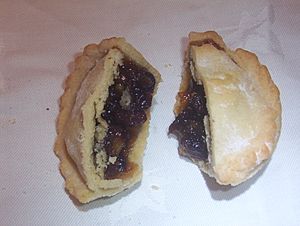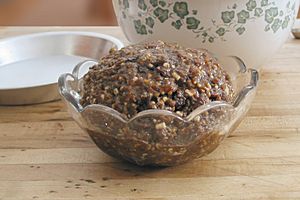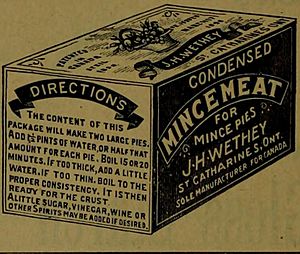Mincemeat facts for kids

Mincemeat is a sweet and spicy mix often used to fill pies or pastries. It's made from chopped dried fruits, spices, and sometimes a type of fat like suet. Long ago, mincemeat actually contained meat, like beef or venison! Today, it's mostly a fruit-based filling, especially popular in countries where English is spoken.
Contents
What's in a Name? The Story of Mincemeat
The word "mince" in mincemeat comes from old words meaning "to chop finely." These words include mincen from Middle English and mincier from Old French. Both of these words can be traced back to a Latin word, minutiare, which means "to chop finely." The name "mincemeat" is a shorter version of an older term, "minced meat," which meant finely chopped meat. In the past, the word "meat" could also mean food in general, not just animal flesh.
How Mincemeat Changed Over Time
English recipes from the 1400s, 1500s, and 1600s describe mincemeat as a mix of meat and fruit used in pies. These early recipes often included sour ingredients like vinegar and wine. But by the 1700s, people started using stronger alcoholic drinks, like brandy, instead.
Adding spices like clove, nutmeg, mace, and cinnamon was common in meat dishes during the Middle Ages and Renaissance. Over time, more sugar was added to mincemeat. This made it much sweeter and helped it change from a savory main dish to a sweet dessert.
Mincemeat in the 1500s
In the 1500s, a recipe for mincemeat pies might have included finely chopped mutton or beef. It would be seasoned with pepper, salt, and a little saffron for color. A good amount of suet (animal fat) or bone marrow would be added, along with a little vinegar. Fruits like prunes, raisins, and dates were also included. Sometimes, the broth from salted beef was used. For a "Royal pastry," butter and egg yolks were mixed with flour to make the crust.
In the mid-to-late 1700s, mincemeat became seen as old-fashioned or country food in Europe. However, in Victorian England (the 1800s), it became popular again as a special Christmas treat.
Mincemeat in the 1800s
A recipe from the 1800s might have called for two pounds of raisins, three pounds of currants, and one and a half pounds of lean beef. It also included three pounds of beef suet, two pounds of sugar, and small amounts of candied citron, lemon peel, and orange peel. Spices like nutmeg were used, along with apples, lemon rind and juice, and half a pint of brandy. All the ingredients were finely chopped and mixed together. The mixture was then pressed into a jar and left for about two weeks before it was ready to use.
Apple Mincemeat: A Healthier Option
By the late 1800s, "apple mincemeat" became a popular choice. It was seen as a "hygienic" (healthy) alternative because it didn't use meat. This version included apples, suet, currants, brown sugar, raisins, allspice, orange juice, lemons, mace, and apple cider. A recipe for apple mincemeat also appeared in The Irish Times newspaper in 1910, using apples, suet, currants, sugar, raisins, orange juice, lemons, spices, and brandy.
Mincemeat Today
By the mid-1900s, most mincemeat recipes no longer included meat. However, they might still use animal fat like suet or butter. Some recipes use solid vegetable fats instead, which makes them suitable for vegans (people who don't eat any animal products).
Some modern recipes still include venison, minced beef, or minced heart. These are mixed with dried fruit, spices, chopped apple, fresh citrus peel, currants, candied fruits, and an alcoholic drink like brandy or rum. Mincemeat is often aged, which means it's stored for a while to let the flavors get stronger. The alcohol helps break down proteins, changing the texture and deepening the taste. Preserved mincemeat can sometimes be stored for many years.
You can make mincemeat at home, but it's also commonly sold in stores. It comes in jars, foil-lined boxes, or tins.
Mince pies and tarts are very popular during the Christmas holidays. In the northeastern United States, mincemeat pies are also a traditional food for Thanksgiving. Like other pies, mince pies are sometimes served with cheese, especially Cheddar cheese.
See also
 In Spanish: Mincemeat para niños
In Spanish: Mincemeat para niños



